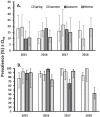Prevalence and risk factors of intestinal protozoan infection among symptomatic and asymptomatic populations in rural and urban areas of southern Algeria
- PMID: 34461837
- PMCID: PMC8406907
- DOI: 10.1186/s12879-021-06615-5
Prevalence and risk factors of intestinal protozoan infection among symptomatic and asymptomatic populations in rural and urban areas of southern Algeria
Abstract
Background: Intestinal parasitic infections are amongst the most common infections worldwide and have been identified as one of the most significant causes of morbidity and mortality among disadvantaged populations. This comparative cross-sectional study was conducted to assess the prevalence of intestinal protozoan infections and to identify the significant risk factors associated with intestinal parasitic infections in Laghouat province, Southern Algeria.
Methods: A comparative cross-sectional study was conducted, involving 623 symptomatic and 1654 asymptomatic subjects. Structured questionnaires were used to identify environmental, socio demographic and behavioral factors. Stool specimens were collected and examined using direct wet mount, formalin-ether concentration, xenic in vitro culture and staining methods.
Results: A highly significant difference of prevalence was found between symptomatic (82.3%) and asymptomatic subjects (14.9%), with the majority attributable to protozoan infection. The most common species in the symptomatic subjects were Blastocystis spp. (43.8%), E. histolytica/dispar (25.4%) and Giardia intestinalis (14.6%) and more rarely Enterobius vermicularis (02.1%), Teania spp. (0.6%) and Trichuris trichiura (0.2%), while in asymptomatic population Blastocystis spp. (8%), Entamoeba coli (3.3%) and Entamoeba histolytica/dispar (2.5%) were the most common parasites detected with no case of helminth infection. Multivariate log-linear analysis showed that contact with animals was the main risk factor for transmission of these protozoa in both populations. Furthermore, living in rural areas was significantly associated with combined protozoan infection in the asymptomatic population, whereas, in the symptomatic population an increasing trend of protozoan infection was detected in the hot season. In addition, Blastocystis spp. and G. intestinalis infection were found to be associated with host sex and contact with animals across the study period.
Conclusions: Based on these results, several strategies are recommended in order to effectively reduce these infections including good animal husbandry practices, health education focused on good personal hygiene practices and adequate sanitation.
Keywords: Algeria; Animal contact; Asymptomatic; Intestinal parasites; Rural areas; Symptomatic; Temporal changes.
© 2021. The Author(s).
Conflict of interest statement
The authors have declared that no competing interests exist.
Figures






Similar articles
-
Prevalence and risk factors of intestinal protozoan and helminth infections among pulmonary tuberculosis patients without HIV infection in a rural county in P. R. China.Acta Trop. 2015 Sep;149:19-26. doi: 10.1016/j.actatropica.2015.05.001. Epub 2015 May 11. Acta Trop. 2015. PMID: 25976412
-
Prevalence of Intestinal Parasites and Associated Risk Factors for Infection among Rural Communities of Chachoengsao Province, Thailand.Korean J Parasitol. 2018 Feb;56(1):33-39. doi: 10.3347/kjp.2018.56.1.33. Epub 2018 Feb 28. Korean J Parasitol. 2018. PMID: 29529848 Free PMC article.
-
Prevalence and associated risk factors of human intestinal parasitic infections: a population-based study in the southeast of Kerman province, southeastern Iran.BMC Infect Dis. 2020 Jan 6;20(1):12. doi: 10.1186/s12879-019-4730-8. BMC Infect Dis. 2020. PMID: 31906872 Free PMC article.
-
Prevalence of intestinal parasitic infections among communities living in different habitats and its comparison with one hundred and one studies conducted over the past 42 years (1970 to 2013) in Malaysia.Trop Biomed. 2014 Jun;31(2):190-206. Trop Biomed. 2014. PMID: 25134888 Review.
-
Prevalence of intestinal protozoan parasites among school children in africa: A systematic review and meta-analysis.PLoS Negl Trop Dis. 2022 Feb 11;16(2):e0009971. doi: 10.1371/journal.pntd.0009971. eCollection 2022 Feb. PLoS Negl Trop Dis. 2022. PMID: 35148325 Free PMC article.
Cited by
-
Detection, Molecular Identification and Transmission of the Intestinal Protozoa Blastocystis sp. in Guinea from a Large-Scale Epidemiological Study Conducted in the Conakry Area.Microorganisms. 2022 Feb 15;10(2):446. doi: 10.3390/microorganisms10020446. Microorganisms. 2022. PMID: 35208899 Free PMC article.
-
Burden of anemia and intestinal parasites in farmers and family members and owned livestock in two geographic locations in Senegal before and during the rainy seasons.One Health. 2022 Jul 8;15:100415. doi: 10.1016/j.onehlt.2022.100415. eCollection 2022 Dec. One Health. 2022. PMID: 36277095 Free PMC article.
-
Prevalence of Blastocystis sp. among cooks in the region of Fez-Meknes (Morocco).Helminthologia. 2023 Jun 4;60(1):36-43. doi: 10.2478/helm-2023-0002. eCollection 2023 Mar. Helminthologia. 2023. PMID: 38659650 Free PMC article.
-
Fiberoptic Bronchoscopic Findings in Patients Suffering from Emerging Pulmonary Lophomoniasis: A First Registry-Based Clinical Study.Interdiscip Perspect Infect Dis. 2022 Jun 16;2022:8034295. doi: 10.1155/2022/8034295. eCollection 2022. Interdiscip Perspect Infect Dis. 2022. PMID: 35722220 Free PMC article.
-
Prevalence of Blastocystis sp. in Morocco: Comparative assessment of three diagnostic methods and characterization of parasite forms in Jones' culture medium.Parasite. 2023;30:64. doi: 10.1051/parasite/2023065. Epub 2023 Dec 20. Parasite. 2023. PMID: 38117274 Free PMC article.
References
-
- WHO. Estimation de l’OMS sur la charge mondiale de morbidité imputable aux maladies d’origine alimentaire: résumé d'orientation. 2015; WHO.FOS/15.02. https://apps.who.int/iris/handle/10665/200048.
MeSH terms
LinkOut - more resources
Full Text Sources
Miscellaneous

